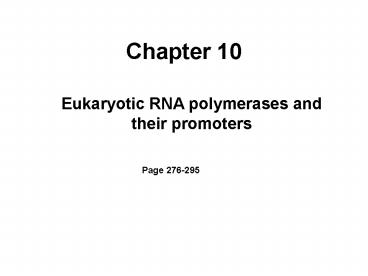Eukaryotic RNA polymerases and their promoters - PowerPoint PPT Presentation
1 / 23
Title:
Eukaryotic RNA polymerases and their promoters
Description:
... enhancers binds transcription factors (activators) to activate transcription. An enhancer can localize upstream, within, or downstream of a gene. How do enhancers ... – PowerPoint PPT presentation
Number of Views:588
Avg rating:3.0/5.0
Title: Eukaryotic RNA polymerases and their promoters
1
Chapter 10
Eukaryotic RNA polymerases and their promoters
Page 276-295
2
(No Transcript)
3
(No Transcript)
4
Polymerase II components can be categorized into
three groups
- Core subunits (Rpb1, 2, 3 similar to bacterial
RNA polymerase subunits ?, ? and ?,
respectively) - Rpb1 -- ?, Rpb2 -- ?, Rpb3 -- ?
- Common subunits (Rpb5, 6, 8, 10, 12)
- Not much is known about these subunits
- 3) Nonessential subunits (Rpb4 and Rpb9)
5
(No Transcript)
6
/?
/?
- Rpb3 may be a functional homologue of E. coli ?
- Both have two monomers per holoenzymes
- Both have similar sizes
- Both are involved in assemblying holoenzymes
7
Common subunits (Rpb5, 6, 8, 10, 12)
- Functions unknown
- Could be important for
- Localization in the nucleus
- Processivity of the holoenzyme
- Fidelity of transcription
- Nonessential subunits (Rpb4 and Rpb9)
- Yeast cells with a deletion in either of these
two genes are viable in normal temperature but
cannot survive in high or low temperatures. - Pol II purified from a yeast mutant deleting Rpb4
also lack Rpb7, suggesting that Rpb4 plays a role
in anchoring Rpb7 to Pol II.
8
Pol II ?4/7
Rpb4 may play a role similar to ? and has limited
sequence homology with ?
9
- What of the followings are the most critical
components for doing an in vitro transcription
assay? - 1) DNA template, 2) RNA polymerase, 3)
Nucleotides - 4) DNA polymerase, 5) radiolabeled UTP, 6) RNA
primers - 1, 4, 5, 6
- 1, 2, 3, 5
- 1, 4, 3, 6
- 1, 2, 5, 6
- 1, 3, 4, 5
- B
10
Heterogeneity of the Rpb1 subunit The Largest
subunit of RNA polymerase II
RPB1 governs the sensitivity of Pol II to
?-amanitin
11
Figure 10.10
12
Three RNA Polymerases have different subunit
compositions and transcribe different class of
genes
They may recognize different promoters
13
Class II Promoters
14
There are also TATA-less promoters
- Promoters for house-keeping genes (GC boxes)
- Promoters of genes that are regulated
developmentally
Specialized genes (cell-type specific) do have a
TATA-box in their promoters.
15
- TATA box locates the start of transcription 30
bp downstream - TATA box sometime is important for the efficiency
of transcription - TATA-binding protein (TBP) binds to TATA-box and
initiates the assembly of transcription factors
and RNA polymerase
16
Initiator --PyPyANT/APyPy -- is sufficient by
itself to direct transcription Downstream
promoter elements (DPE) -- quite common in
fruitfly genes. Found 30 bp downstream of the
transcription initiation site Have the consensus
sequence -- G(A/T)CG -- behave as a TATA-box BRE
-- (G/C)(G/C)(G/A)CGCC -- TFIIB-binding site
Upstream element
17
Class I promoter (Pol I promoter)
Relatively simple -- one template (the rRNA
precursor gene)
18
The spacing between the two elements is important
19
Class III promoter (Pol III promoter)
20
A promoter must have
- a TATA box
- a GC box
- an element that direct where RNA polymerase
should start - a CAT box
- a site where primer can bind
- C
21
Class III promoter (Pol III promoter)
Classical class III promoter
Unlike class I and II promoters, classical class
III promoters locate within the genes.
U6 snRNA, 7SL, and 7SK RNA gene still need
elements 5 of the genes. Their promoters
resemble class II promoters (nonclassical class
III promoter).
22
Enhancers and Silencers
Elements that are not a part of the promoter but
can either enhance (enhancer) or inhibit
(silencer) transcription at a manner that is
position- and orientation-independent.
23
How do enhancers work?
- An enhancers binds transcription factors
(activators) to activate transcription - An enhancer can localize upstream, within, or
downstream of a gene.































